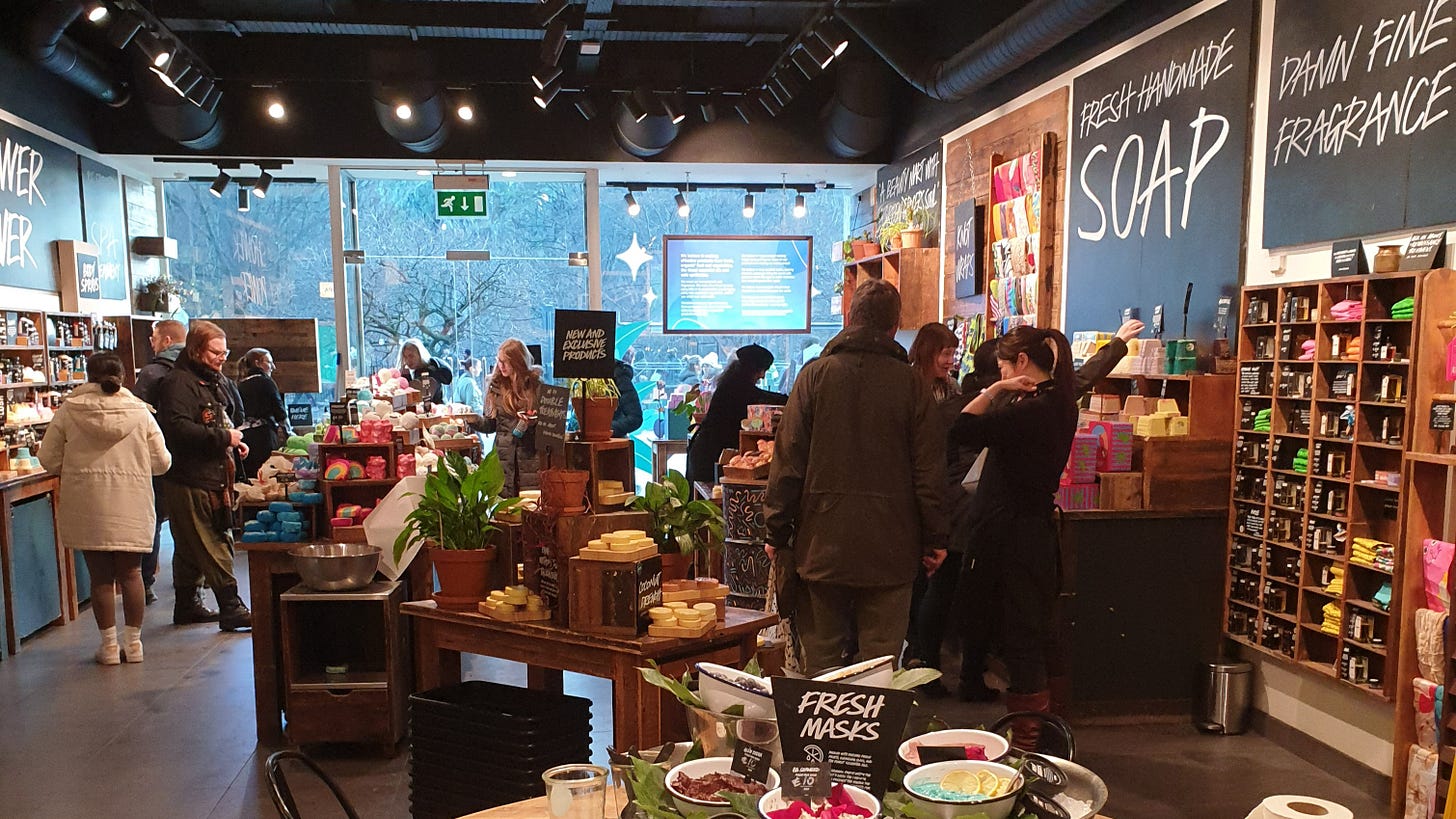I write this post with a certain amount of trepidation. Financial analysis is a critically important discipline for any business, and particularly for retailers. Do you really understand the actual profitability of all the products you sell (including all the messy costs like returns, faults and space consumed in the warehouse)?
For many businesses, the answer is ‘not nearly well enough’. If that’s you, then be careful with the rest of this post because there is a danger you’ll take it as an excuse not to do that analysis, and that would be an expensive mistake.
But.
There are times when a straightforward financial analysis or even a more involved cost-benefit or time and motion study only tells you a part of the story. Consider this Lush store in Edinburgh, pictured in January:
I stood and watched this small (maybe 1000 sq ft) shop for a while whilst some of the family shopped, and what really stood out for me was that it was packed with store colleagues - I counted 7 at one time on the shop floor.
Now it wouldn’t be difficult to build the spreadsheet that proved that was far too many people to have on at the same time. Indeed, many retailers are moving from an era when the received wisdom on small format stores was “we should have three people but can probably get away with two” towards “I wonder if we can have just one person run the store per shift”.
But a few minutes of observation revealed that the staffing model in this store was really working for them. Every customer coming into the store was greeted and made to feel welcome, and colleagues were then actively engaging whilst customers browsed, demonstrating products and explaining what was in them and how they were made.
This is not, by the way, a call to put more colleagues in your stores without thought. This Lush store stayed just the right side of “I’m constantly being hassled and just want to browse” but I have vivid memories of visiting the Microsoft store on Regent Street when it first opened and practically being kidnapped by gangs of roaming sales people desperate to sell something. Balance in all things!
This brand, though, knows what it is about. The warm greeting, the active product demonstration and the abundance of product on the shelves (another thing a spreadsheet would tut about) are all carefully designed to win over its very difficult to reach target customer base and it does so brilliantly.
This is another example of the topic we explored in an earlier post, Experience Matters, when we looked at the decision by Tesco to close all of its fresh food counters in stores.
What both the Lush and Tesco examples illustrate is the danger that financial analysis tends to focus on those things which are easiest to measure.
financial analysis tends to focus on those things which are easiest to measure
That often means costs. We can calculate precisely what having 7 colleagues in a store, or operating a fresh fish counter in a supermarket costs.
The benefit side of the equation can be harder to work out. How much fish the fish counter sells and at what margin is fairly easy to add up, but does the presence of the fish counter result in the supermarket selling more pre-packed fish from the nearby shelves? Does it contribute in any way to customers continuing to visit the store rather than migrating to the discounter nearby? Does it create an overall impression of product-expertise and range authority that pays back in other ways?
Some readers will now be screaming words like “control group” and “test and learn” at their screens, and of course in many circumstances these are sensible ways to make the benefit side of the analysis clearer. If you are in doubt about something, try it for a while in a few stores and measure the difference between those and stores where you didn’t try it.
But even that requires care. (I feel slightly bad saying that having written an entire book extolling the virtues of tests and control groups).
That’s because some of the benefits we generate from investments we make in our business might take longer to become apparent, or manifest themselves in ways that even a carefully constructed experiment might struggle to quantify.
In future posts we’ll talk more about some of the ingredients that make a great shopping experience and we’ll find that some of those are indeed surprising and difficult to quantify precisely. But as a taster, consider this incense shop in Kyoto, Japan:
Japanese towns are stuffed with shops like these. They are brightly lit (think of that electricity bill), often sell a fantastically narrow range of products (a single type of biscuit, for example, or as in this case a small range of incense) and you can bet you’ll be greeted when you walk in too.
None of it makes any sense, until you consider what it adds up to. The overall impression is so welcoming, so rarefied and meditative that the whole experience adds huge perceived value to the products being sold. And yes, that certainly translates nicely into gross margin.
We have a word for the sum total of many intangibles that add up to your overall experience of a business - we call it their brand.
And that brings us to an interesting conclusion to ponder. When a business is strongly brand-led (like Lush in our example here, but consider other strong brand-led retailers like Hotel Chocolat or Warhammer too) they are often characterised as making decisions about what to do based on what the brand requires, rather than based on clinical financial analysis.
Does that make them fluffy, woolly and mean that they are ‘leaving profit on the table’? Or does it mean that by using brand as a shorthand for the overall customer experience they are trying to deliver they have found a way to tame the spreadsheet monster and avoid death by a thousand cuts?
Of course, to the extent that a strong brand identity can indeed act as a guide to business investment decisions and a counter-point to financial analysis, that can’t be taken as an excuse for the business to do whatever it wants “because of the brand”. Financial discipline is critical for any retailer, and highlighting a successful business like Lush is in danger of failing to take account of many businesses which have failed after over-investing in things that feel good to the brand owners but ultimately don’t make a difference to customers.
So how do we get that balance right? How do we run a business which is simultaneously financially literate, understands key profit drivers and doesn’t waste capital on the one hand, but also delivers a strong, differentiating brand-led customer experience on the other?
That’s a challenge all of us on retail boards or in management teams are wrestling with all the time, whether we realised it or not. What’s your experience? Comments are open, and I’d love to hear from you.






Ian, that is an excellent debate to open! Arca Blanca works with a variety of retailers across Europe, and this is a very live discussion in many quarters. To add to your points the answers will very much depend on the question. While this may be a truism, consider it in the context of i) what makes a good and valuable customer? ii) what is it that the customer values? and iii) what are their characteristics?
When those questions are asked there is often an assumption about the answer, such as the financial life-time-value of a customer or what the demographics look like – in effect limited by what I would put into said spreadsheet in the first instance. However, increasingly we use data science to help retailers identify much more complex patterns, in combinations that we would be unlikely to imagine ourselves. Like the company which found that customers are 7 times more valuable if they live in a location with certain characteristics, shop in a town with a combination of other characteristics (competition, parking, etc), are of a certain demographic and have access to a certain format with a specific range and service level. The number of combinations is almost limitless and this is where AI will offer retailers access to a whole new set of insights – not necessarily to make decisions for them (that is an entirely different – and equally interesting discussion), but to help them evaluate what matters for their brand and hence where to invest.